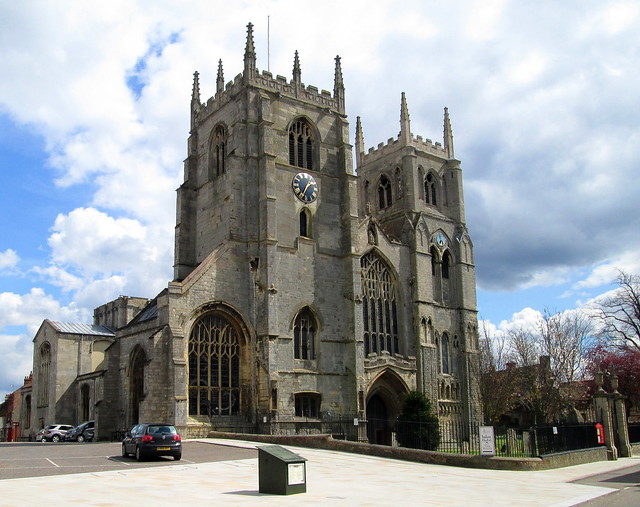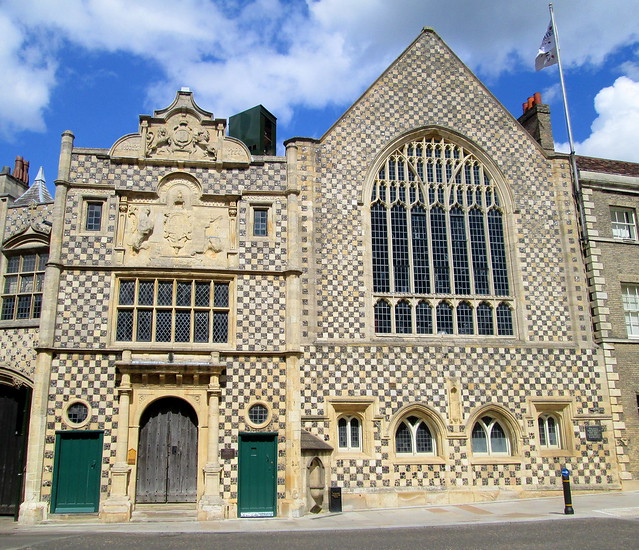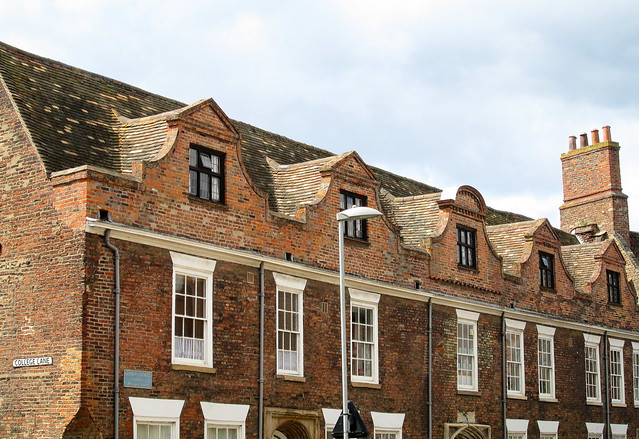Many moons ago when I was a teenager we lived in East Anglia for a couple of years, Essex actually. One of the places that popped up a lot on the local TV and newspapers was King’s Lynn in Norfolk. It’s 97 miles north of London, we lived much closer to London in Braintree and I never did get to visit King’s Lynn back then. We rectified that on our last trip down to England on our way to Harwich and the ferry to Holland. Below is a photo of King’s Lynn Minster which is over 900 years old and stone built as you can see.
Somehow King’s Lynn wasn’t at all as I expected it to be. It’s a lovely place but I was surprised by the architecture of the town, it’s very old of course and I had expected it to be all white plaster and half-timbered buildings like most of the old buildings in Essex. But most of the old buildings are made of stone, sometimes small red Tudor bricks, but not nearly as much of that as I had expected.

But as you can see King’s Lynn is mainly built of stone and some very interesting designs too. I was particularly impressed with The Guild Hall which has a chequered design using two different types of stone.
You could be forgiven for thinking you were in Holland looking at the photo below, it’s a typical Dutch design. In fact the surrounding countryside is very like Holland, all flat fields with big ditches. There are even old windmills scattered around, the only difference is that they seem to grow daffodils commercially in Norfolk instead of tulips.
I read The Crossing Place by Elly Griffiths recently and the setting was the King’s Lynn area, so I was really pleased we had gone there because I could imagine it all so much better. It’s an interesting place to visit and of course the locals just call it Lynn.




Very pretty! I really like designs in brick – the red and black brick on the Tudor side at Hampton Court Palace is so striking to see in person. Did you like The Crossing Places? I read it a while back and thought it was pretty good.
Anbolyn,
Yes I did enjoy The Crossing Places and will read more in the series. Can you believe I’ve never been to Hampton Court?!
I’ve been to Norfolk a number of times yet never been to King’s Lynn. One day I’ll get there! The Crossing Place sounds like a great read.
Sandra,
I was surprised just how similar Norfolk is to Holland, they (whoever they are) say that Norfolk is a bit weird but I liked it. I’ll blog about The Crossing Place soon.
Thanks for the photos of King’s Lynn. I love the Ruth Galloway (Elly Griffiths) books, so now I can picture the locations better. I don’t think I’ve ever been to that part of England.
Joan,
Norfolk is quite remote really and very rural. Thanks for pointing me in the direction of Ruth Galloway.
Many of my 17th-century immigrant ancestors were Puritans who emigrated from Norfolk in England to Massachusetts in what is known here as “The Great Migration.” This huge migration took place between 1629-1640. After 1640, very few immigrants from England arrived until late in the 1600s. Great Migration migrants also came from Suffolk and Essex. Some of my ancestors originated in Suffolk but few from Essex. I’d love to visit Norfolk, and I’m very interested but not too surprised that its landscape is similar to the Netherlands.
Katrina,
I forgot to mention this was a really fun post!
J.
Judith,
The people in Norfolk still have what sounds to me like an American tinge to their accent. For one thing they say noo for new – or nyew as I and most other Brits would say. Do you know exactly where your relatives came from in Suffolk and Essex?
From what I’ve seen the old wooden clapboard houses in the US are just like some of the ones in East Anglia, they didn’t change the designs at all.
I think that yonks ago Holland and England were joined together before some seismic shift.
Magnificent and beautiful buildings – thank you for the photos!
Such a sense of great age there: NZ’s oldest buildings are in Kerikeri in the far North of the North Island and were built around 1820-21.
Valerie,
I had absolutely no idea that New Zealand had only been settled so recently, I suppose that was around some Highland Clearance time too, or did the Scottish settlers come along later?
The Scottish settlers were later. This link http://www.teara.govt.nz/en/scots/page-4 gives a brief outline. My Scottish and English great-grandparents all came to NZ in the early 1870s which was a time of great opportunity in a rapidly developing country. So, comparatively, very recently!
Valerie,
Thanks for that interesting link. That minister Norman McLeod and his flock must have had some energy, or maybe it was desperation to keep moving until they found a better life, which presumably they did in NZ.
Looks like a really cool place to these American eyes! All that fancy brickwork, don;t see stuff like that here!
Stefanie,
It’s definitely worth a visit if you are in that area. Stone is quite unusual in the south of England.